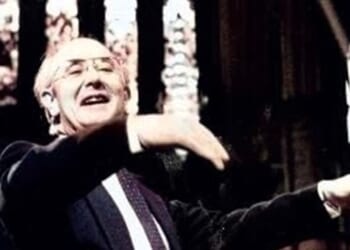(Paarse Pepers) — It never ceases to amaze me that in the modern world people are particularly afraid of words. People no longer seem to fear sin or folly, only misunderstandings. And as if it weren’t clear enough: there is no truth that cannot be misunderstood. Roman Catholic theology has always placed an extraordinary emphasis on Christ as the only Savior. That is precisely why I have never seen any threat in the way Mary is spoken of. Christ’s position is so absolute that it would be absurd to think that anyone could truly overshadow Him. Cooperation does not mean rivalry. If God truly became man, then He not only humbled Himself, but He also made Himself dependent on human obedience: first on Mary, later on the apostles, and ultimately on all of us. Cardinal Fernandez is seeing ghosts when he says that it is no longer advisable to use the title “Co-Redemptrix” for Mary.
So I see nothing unreasonable in the idea that Mary, in a manner totally subordinate and arising from grace, participated in the work of Christ. The term “Co-Redemptrix” is not as shocking as some fear. And frankly, if Cardinal Fernandez is afraid that people will put Mary on an equal footing with Christ, then the problem is not with Mary but with Fernandez. It is precisely Mary’s presence that reminds me that the Christian faith is not an idea, a philosophy, or a moral system, but a story. The factual reality of Mary’s cooperation in the work of our redemption does not stem from human invention but from the fact that God Himself decided to work through human mediation. Every step in the history of salvation shows that God does not act in spite of man but through man. Mary’s “fiat” is the first, and perhaps clearest, example of this supernatural cooperation.
When the Church speaks of Mary as Co-Redemptrix—a term not used lightly by saints and popes—it does not mean that her merits have any value in themselves, or that she detracts from Christ’s unique place. Tradition means that, through an ineffable grace, she is involved in an incomparable way in what Christ accomplished. This doctrine has undergone a certain development. The development of doctrine does not mean a change in dogma but the unfolding of what was always present in its seed. It seems to me that the title “Co-Redemptrix” is not a novelty but a consequence of what has always been believed: that Mary, through grace, was the instrument through which the Word became flesh, and that she participated in Christ’s work of salvation through faith, love, and suffering.
For centuries the title “Co-Redemptrix” was peacefully written in the pages of the Church. Saints did not use the word out of recklessness but out of reverence. Thus St. Bonaventure spoke of Mary as the one who “worked with Christ in redemption.” Bernardino of Siena had the courage to praise the Virgin’s cooperation with the Son, because he knew that cooperation (co-operatio) is not equality. The Church Fathers were not concerned that the faithful would forget Christ as soon as Mary was praised. They trusted that people would understand the distinction as they could understand the distinction between the Sun and the moon.
And the popes? Leo XIII spoke of Mary as the one “through whom we received the Mystery of Redemption.” Pius X spoke of her unique union with Christ in his suffering. Benedict XV used words that would be considered dangerous today: he called her struggle on the Cross “almost equal” in intention to that of Christ—almost, I repeat, not quite equal, and only a poorly listening world would fail to hear the difference. Pius XI, the pope who was not known for romantic weaknesses, even explicitly used the word “Co-Redemptrix” in a speech, as if it were the most natural thing in the world for the Mother of the Lord to bear such a title. The saints and popes did not fear that Mary would become too great. They feared above all that we would become too small.
READ: SSPX head says Co-Redemptrix document ‘dethrones’ Mary, offers Mass in reparation
It is a strange phenomenon that Fernandez wants to ban a word because he is afraid that it will be misunderstood. You would expect that you would first try to make it understood by simply explaining it. If someone says that a map is confusing, teach them how to read a map. You don’t tear the map to shreds and then declare the world flat. If you say that a theological term is dangerous, you could explain that “co” comes from “cum,” “with”; it is not a coordinating term. There has never been any misunderstanding about that. But instead, the head of the Dicastery for the Doctrine of the Faith renders the word suspect.
If God was not afraid to give a girl from Nazareth the title “Mother of God,” why should we be afraid to give her lesser titles? Ancient heretics cringed at this divine paradox, but the Church did not. Who can imagine a humbler creature than that same Mary? And yet God gave her a title that shook the universe. This proves that God delights in creating greatness out of humility.
Catholicism is the faith that teaches us that God works together with human beings. The Gospel begins with cooperation: an angel waits for a human being’s answer, the human being says “yes,” and heaven holds its breath. If that is not cooperation, then the word does not exist. The whole story of the Incarnation is the triumph of God’s willed cooperation between Creator and creature. And if humanity—through Mary—was allowed to be involved in the coming of the Savior, why not in His sacrifice on the Cross, in a manner entirely dependent on God’s grace? It is better and also easier to explain big words than to heal a small faith. Converting people to Christianity is still an enormous task. The Church has never wanted to diminish the truth to appease people. It has always wanted to elevate people so that they can bear the truth.
I am bold enough to offer a few suggestions: 1) Teach people the meaning of words instead of discarding them. 2) Ecclesiastical continuity should not be dependent on contemporary sensibilities. 3) Paradox and rich language are part of Catholic identity. And 4) Mary’s role is not a threat to Christ but rather a confirmation of His Incarnation and love for human cooperation.
+Rob Mutsaerts
This article was originally published in Dutch and can be found on Bishop Robert Mutsaerts’ blog “Paarse Pepers.”

















